For a long time now I tried to make my creature work. Being from an alien planet, I wished it to be humanoid and capable of flight, while also making it able to slip into small crevices, however, as flight usually involve some kind of support system (be it an endo or exoskeleton), both traits seems essentially mutually exclusive. However, after observing the hospital monster in the 3rd season of the series Stranger Things, I started to wonder the possibility of a different approach(spoilers ahead).
To put into context, the hospital monster is a creature made essentially of a conglomerate of cells and tissues of 2 humans, being capable to move like a vertebrate while also being able to squeeze through crevices much smaller than its size should allow. A specific behavior that called my attention about this being was how, while sliding though a sewer duct to escape, it left behind some bones which were too large for it to pass through. This last behavior showed it still had them to begin with, likely justifying its ability to move in a way much more similar to a vertebrate or arthropod than to a mollusk when the situation called for it.
Given this, I'd like to use a similar concept, with an omnivorous, human-sized humanoid creature having a more or less soft body and using certain hardened, bone-like structures to support itself (predominantly its limbs and parts of the chest, in an approximation of the ribs and sternum), but also being able to abandon said support structures, should it need to squeeze through tight spaces to escape, substituting them later. This however would, as far as I know, require a muscular system that can function like that of an octopus and like that of a vertebrate or arthropod depending on whether or not there's a skeletal system at the moment.
Leaving apart whether it could evolve naturally, Could such a concept of a creature which can discard its skeletal system (be it an endoskeleton or exoskeleton) in favor of the ability to squeeze into small crevices be implemented given our understanding of life and the laws of our universe?. While I'd also like to explore this concept regarding flight (although with a smaller creature), I'd prefer to focus on overall mobility on land in this question.

